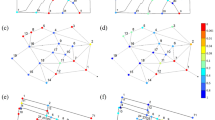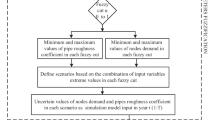Abstract
This paper presents cross entropy (CE) optimization for optimal design of water distribution networks (WDN) under demand uncertainty. In design of WDNs, it is desired to achieve a minimum cost WDN that provides higher reliability in meeting the demands. To achieve these goals, an optimization model is formulated for design of WDNs with an objective of minimizing the total cost of WDN subject to meeting the nodal demands at a specified system reliability, mass conservation and other physical constraints. The uncertainty in future water demands is modeled using the theory of fuzzy random variable (FRV). The water demand at each node is assumed to be following a normal distribution with a fuzzy mean, and 10 % (or 20 %) of the fuzzy mean as its standard deviation. The water demand is represented as a triangular fuzzy number with the random demand as its kernel, and the interval of ±5 % (or ±10 %) variation of the random demand as its support for two scenarios. The fuzzy random system reliability (R) of WDNs is defined on the basis of necessity measure to assess system performance under fuzzy random demands and crisp head requirements. The latin hypercube sampling method is adopted for sampling of uncertain demands. The methodology is applied to two WDNs, and optimization models are solved through cross entropy optimization for different levels of reliability, and generated tradeoffs between the cost and R. On comparing the solutions obtained with the proposed methodology with earlier reported solutions, it is noted that the proposed method is very effective in producing robust optimal solutions. On analyzing the tradeoffs between reliability and costs, the results show that negligence of uncertainty can lead to under design of the WDNs, and the cost increases steeply at higher levels of reliability. The results of the two case studies demonstrate that the presented CE based methodology is effective for fuzzy-probabilistic design of WDNs.





Similar content being viewed by others
References
Abebe A, Guinot V, Solomatine D (2000) Fuzzy alpha-cut vs. Monte Carlo techniques in assessing uncertainty in model parameters. Proc. 4th Int. Conf. on Hydroinformatics, Iowa City, US, pp 1–8
Babayan AV, Savic DA, Walters GA, Kapelan ZS (2007) Robust least-cost design of water distribution networks using redundancy and integration-based methodologies. J Water Resour Plan Manag 133(1):67–77
Branisavljevic N, Iveti M (2006) Fuzzy approach in the uncertainty analysis of the water distribution network of BECEJ. Civ Eng Environ Syst 23(3):221–236
Cunha MC, Sousa J (2001) Hydraulic infrastructures design using simulated annealing. J Infrastruct Syst 7(1):32–39. doi:10.1061/(ASCE)1076-0342(2001)7:1(32)
De Boer P-T, Kroese DP, Mannor S, Rubinstein RY (2005) A Tutorial of the Cross Entropy Method. Annals of Operations Research 134: 19–67
Derya S, Lansey K (2009) Effect of uncertainty on water distribution system model design decisions. J Water Resour Plan Manag 135(1):38–47
Dubois D, Prade H (1988) Possibility theory. Plenum, New York
Fu G, Kapelan Z (2011) Fuzzy probabilistic design of water distribution networks. Water Resour Res 47:1–12. doi:10.1029/2010WR009739, W05538
Fu G, Butler D, Khu ST, Sun S (2011) Imprecise probabilistic evaluation of sewer flooding in urban drainage systems using random set theory. Water Resour Res 47:W02534. doi:10.1029/2009WR008944
Giustolisi O, Laucelli D, Colombo AF (2009) Deterministic versus stochastic design of water distribution networks. J Water Resour Plann Manage ASCE 135(2):117–127
Gupta R, Bhave PR (1996) Reliability based design of water distribution systems. J Environ Eng ASCE 122(1):51–54
Gupta R, Bhave PR (2007) Fuzzy parameters in pipe network analysis. Civil Eng Environ Syst 24(1):33–54
Huang T, Tang W (2009) Risk model with fuzzy random individual claim amount. Eur J Oper Res 192:879–890. doi:10.1016/j.ejor.2007.10.035
Jinesh Babu KS and Vijayalakshmi DP (2013) Self-adaptive PSO-GA hybrid model for combinatorial water distribution network design. J of Pipeline Systems Engineering and Practice 4 (1): 57 - 67
Kadu MS, Gupta R, and Bhave PR 2008 Optimal Design of Water Networks Using a Modified Genetic Algorithm with Reduction in Search Space. J Water Resour Plang and Mgmt, ASCE, 134(2): 147–160
Kapelan ZS, Savic DA, Walters GA (2005) Multiobjective design of water distribution systems under uncertainty. Water Resour Res 41, W11407. doi:10.1029/2004WR003787
Kullback S, Leibler RA (1951) On information and sufficiency. Ann Math Stat 22:79–86
Kwakernaak H (1978) Fuzzy random variables—I. Definitions and theorems. Inf Sci 15(1):1–29. doi:10.1016/0020-0255(78)90019-1
Lansey K (1997) Uncertainty in water distribution network modeling. J Contemp Water Res Educ 3(1):22–26
Lansey K, Duan N, Mays LW, Tung YK (1989) Water distribution design under uncertainty. J Water Resour Plan Manag ASCE 115(5):630–645
Liu B (2001) Fuzzy random chance-constrained programming. IEEE Trans Fuzzy Syst 9(5):713–720
McKay MD, Beckman RJ, Conover WJ (1979) A comparison of three methods for selecting values of input variables in the analysis of output from a computer code. Technometrics 21(2):239–245
Merz B, Thieken AH (2005) Separating natural and epistemic uncertainty in flood frequency analysis. J Hydrol 309(1–4):114–132
Möller B, Beer M (2004) Fuzzy randomness: uncertainty in civil engineering and computational mechanics. Springer, Berlin
Ostfeld A and Tubaltzev A (2008) Ant Colony Optimization for Least-Cost Design and Operation of Pumping Water Distribution Systems. J Water Resour Plang and Mgmt, ASCE, 134(2): 107–118
Perelman L, Ostfeld A (2007) An adaptive heuristic cross-entropy algorithm for optimal design of water distribution systems. Eng Optim 39(4):413–428
Reca J, Martinez J, Gil C, Banos R (2008) Application of several meta-heuristic techniques to the optimization of real looped water distribution networks. Water Resour Manage 22(10): 1367–1379
Revelli R, Ridolfi L (2002) Fuzzy approach for analysis of pipe networks. J Hydraul Eng 128(1):93–101
Ross JL, Ozbek MM, Pinder GF (2009) Aleatoric and epistemic uncertainty in groundwater flow and transport simulation. Water Resour Res 45:W00B15. doi:10.1029/2007WR006799
Rossman LA (2000) Epanet2 users manual. report, U.S. Environ. Prot. Agency, Washington, DC
Rubinstein RY (1997) Optimization of computer simulation models with rare events. Eur J Oper Res 99:89–112
Schaake J, Lai D (1969) Linear programming and dynamic programming applications to water distribution network design, Rep. No. 116. Dept. of Civil Engineering, Massachusetts Institute of Technology, Cambridge
Shannon CE (1948) A mathematical theory of communication. Bell System Tech J 27:379–423
Shapiro AF (2009) Fuzzy random variables. Insur Math Econ 44(2):307–314. doi:10.1016/j.insmatheco.2008.05.008
Spiliotis M, Tsakiris G (2012) Water distribution network design under variable water demand. Civil Eng Environ Syst (Taylor and Francis) 29(2):107–122
Tolson BA, Maier HR, Simpson AR (2004) Genetic algorithms for reliability-based optimization of water distribution systems. J Water Resour Plan Manag ASCE 130(1):63–72
Xu C, Goulter IC (1998) Probabilistic model for water distribution reliability. J Water Resour Plan Manag ASCE 124(4):218–228
Xu C, Goulter IC (1999) Reliability-based optimal design of water distribution network. J Water Resour Plan Manag ASCE 125(6):352–362
Zadeh LA (1965) Fuzzy sets. Inf Control 8:338–353
Zecchin AC, Simpson AR, Maier HR and Nixon JB (2005) Parametric Study for an Ant Algorithm Applied to Water Distribution System Optimization. IEEE Trans on Evol Comp 9( 2): 175–191
Author information
Authors and Affiliations
Corresponding author
Rights and permissions
About this article
Cite this article
Shibu, A., Reddy, M.J. Optimal Design of Water Distribution Networks Considering Fuzzy Randomness of Demands Using Cross Entropy Optimization. Water Resour Manage 28, 4075–4094 (2014). https://doi.org/10.1007/s11269-014-0728-6
Received:
Accepted:
Published:
Issue Date:
DOI: https://doi.org/10.1007/s11269-014-0728-6




